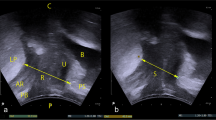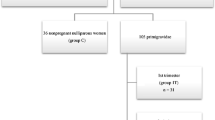Abstract
Introduction and hypothesis
The aims of the present study were to investigate the correlation among vaginal resting pressure and pelvic floor muscle (PFM) strength and endurance, and the correlation between the same variables and levator hiatus (LH) dimensions in nulliparous pregnant women.
Methods
This was a cross-sectional study of 300 nulliparous pregnant women, mean age 28.7 years (SD 4.3) and pre-pregnancy BMI 23.9 kg/m2 (SD 3.9), assessed at mean gestational week 20.8 (±1.4). Vaginal resting pressure and PFM strength and endurance were measured using a high precision pressure transducer connected to a vaginal balloon. LH dimensions (transverse and anterior–posterior diameters_ and LH area were assessed using 3/4D transperineal ultrasound in the axial plane of minimal hiatal dimensions using render mode. The Pearson correlation was used to analyze correlations among vaginal resting pressure and PFM strength and endurance, and between PFM variables and LH dimensions. Level of significance was set at 0.05.
Results
Pelvic floor muscle strength and vaginal resting pressure were significantly, but weakly correlated (r = 0.198, p < 0.001). PFM strength and endurance showed a strong correlation (r = 0.929, p < 0.001). High vaginal resting pressure was moderately correlated with a small LH area at rest (r = −0.451, p < 0.001), but there was no significant correlation neither between PFM strength and LH area at rest (r = −0.012, p = 0.84) nor between muscle endurance and LH area at rest (r = −0.014, p = 0.81). A strong PFM contraction correlated moderately with reduction of the LH area (r = −0.367, p < 0.001).
Conclusions
Pelvic floor muscle strength and endurance are strongly correlated, butdo not correlate with a smaller LH area at rest.
Similar content being viewed by others
References
Moore K, Dumoulin C, Bradley C, Burgio K, Chambers T, Hagen S, Hunter K, Imamaura M, Thakar R, Williams K, Vale L (2013) Adult conservative management. In: Abrams P, Cardozo L. Khouy S, Wein A (eds): Incontinence. 5th edn. Committee 12: 1101–1227
Dumoulin C, Hay-Smith J (2010) Pelvic floor muscle training versus no treatment, or inactive control treatments, for urinary incontinence in women. Cochrane Database Syst Rev (1):CD005654
Urinary incontinence in women. www.nice.guidelines Update November 2013
Boyle R, Hay-Smith EJC, Cody JD, Mørkved S (2012) Pelvic floor muscle training for prevention and treatment of urinary and faecal incontinence in antenatal and postnatal women (review). Cochrane Database Syst Rev (10):CD007471. DOI: 10.1002/14651858.CD007471.pub2
Knuttgen HG, Komi PV (2003) Basic considerations for exercise. In: Komi PV (ed) Strength and power in sport, vol 3. Encyclopedia of sports medicine, 2nd edn. Blackwell Science, Oxford, pp 3–7
Messelink B, Benson T, Berghmans B, Bø K, Corcos J, Fowler C, Laycock J, Lim Huat-Chye P, van Lunsen R, Lycklama A, Nijeholt G, Pemberton J, Wang A, Watier A, van Kerrebroeck P (2005) Standardization of terminology of pelvic floor muscle function and dysfunction: report from the pelvic floor clinical assessment group of the international continence society. Neururol Urodyn 24:374–380
Kruger J, Murphy B, Thompson S (2007) Childbirth and sportswomen: the perceptions of obstetric caregivers. Vision 14(2):7–15
Bø K, Kvarstein B, Hagen R, Larsen S (1990) Pelvic floor muscle exercise for the treatment of female stress urinary incontinence. II. Validity of vaginal pressure measurements of pelvic floor muscle strength and the necessity of supplementary methods for control of correct contraction. Neurourol Urodyn 9:479–487
Bø K, Kvarstein B, Hagen R, Oseid S, Larsen S (1990) Pelvic floor muscle exercise for the treatment of female stress urinary incontinence, I: Reliability of vaginal pressure measurements of pelvic floor muscle strength. Neurourol Urodyn 9:471–477
Brækken IH, Majida M, Engh ME, Bø K (2009) Test-retest of pelvic floor muscle contraction measured by 4D ultrasound. Neurourol Urodyn 28:68–73
Dietz HP, Shek C, Clarke B (2005) Biometry of the pubovisceral muscle and levator hiatus by 3D pelvic floor ultrasound. Ultrasound Obstet Gynecol 25:580–585
Dietz HP, Wong V, Shek KL (2011) Simplified method for determinating hiatal biometry. Aust NZ J Obstet Gynecol 51:540–543
Braekken IH, Majida M, Engh ME, Bø K (2009) Pelvic floor function is independently associated with pelvic organ prolapse. BJOG 116:1706–1714
Majida M, Brækken IH, Umek W, Bø K, Saltyte JB, Engh ME (2009) Interobserver repeatability of three- and four dimensional transperineal ultrasound assessment of pelvic floor muscle anatomy and function. Ultrasound Obstet Gynecol 33:567–573
Siafarikas F, Staer-Jensen J, Braekken I, Bo K, Engh ME (2013) Learning process for performing imaging and interobserver reliability study. Ultrasound Obstet Gynecol 41(3):312–317
Morin M, Gravel D, Bourbonnais D, Dumoulin C, Quellet S, Pilon JF (2010) Application of a new method in the study of pelvic floor muscle passive properties in continent women. J Electromyogr Kinesiol 20:795–803
Frawley HC, Galea MP, Phillips BA, Sherburn M, Bø K (2006) Reliability of pelvic floor muscle strength assessment using different test positions and tools. Neurourol Urodyn 25:236–242
Elenskaia K, Thakar R, Sultan AH, Sheer I, Beggs A (2011) The effect of pregnancy and childbirth on pelvic floor muscle function. Int Urogynecol J 22:1421–1427
Braekken IH, Majida M, Ellstrøm ME, Bø K (2014) Is pelvic floor muscle strength, endurance and vaginal squeeze pressure associated with pelvic floor muscle thickness and levator hiatus? A cross-sectional 3D ultrasound study. Neurourol Urodyn 33:115–120
Bø K, Hilde G, Jensen JS, Siafarikas F, Engh ME, Bø K (2013) Too tight to give birth? Assessment of pelvic floor muscle function in 277 nulliparous pregnant women. Int Urogynecol J 24:2065–2070
Toozs-Hobson P, Balmforth J, Cardozo L, Khullar V, Athanasiou S (2008) The effect of mode of delivery on pelvic floor functional anatomy. Int Urogynecol J 19:407–416
Balmforth J, Toosz-Hobson P, Cardozo L (2003) Ask not what childbirth can do to your pelvic floor but what your pelvic floor can do in childbirth. Neurourol Urodyn 22:540–542
Acknowledgements
We thank midwife Tone Breines Simonsen and physical therapist Kristin Gjestland for excellent work with recruiting participants, clinical testing and data entry and Professor of biostatistics Ingar Holme, Department of Sports Medicine, Norwegian School of Sport Sciences for valuable advice on statistical analyses.
Funding
The study was funded by the South-Eastern Norway Regional Health Authority and The Research Council of Norway.
Conflict of interest
None.
Author information
Authors and Affiliations
Corresponding author
Rights and permissions
About this article
Cite this article
Bø, K., Hilde, G., Tennfjord, M.K. et al. Pelvic floor muscle variables and levator hiatus dimensions: a 3/4D transperineal ultrasound cross-sectional study on 300 nulliparous pregnant women. Int Urogynecol J 25, 1357–1361 (2014). https://doi.org/10.1007/s00192-014-2408-8
Received:
Accepted:
Published:
Issue Date:
DOI: https://doi.org/10.1007/s00192-014-2408-8




